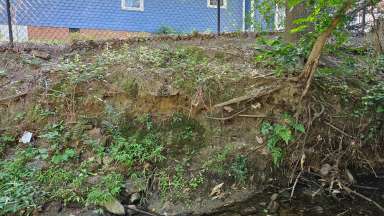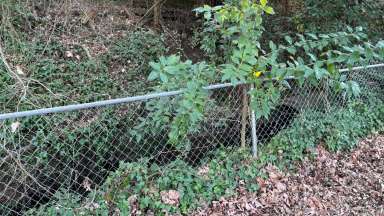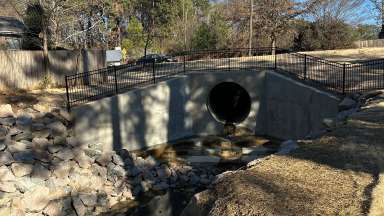Jump To:
What is impervious surface area?
Impervious surface area is any material that significantly reduces or prevents natural infiltration of water into the soil. Impervious surfaces include, but are not limited to:
- Roofs
- Patios and decks
- Balconies
- Streets and sidewalks
- Parking areas
- Driveways
- Any concrete, stone, brick, asphalt, artificial turf, or compacted gravel surfaces
Read more about impervious surface area in UDO Article 12.2.
Impervious Surface Area Examples
- Impermeable surfaces (like asphalt, concrete, and wood) are 100% impervious.
- Slatted wood decks that allow water to drain through the slats to an unpaved surface below are 50% impervious. If the area covered by the deck is washed gravel, the deck is 30% impervious.
- Non-gravel natural footpaths, water surfaces of swimming pools, and drainfields are completely pervious (0% impervious).
How can I determine my maximum impervious surface limitation?
Residential lots fall into one of three categories involving impervious limitations: no impervious limits, lot specific impervious limits, or impervious limits related to residential zoning. See the City’s Stormwater for Residential Homeowners page for determining which option applies to your residential lot.
What if I want to exceed my maximum impervious limitations?
There are two options that may be used by a property owner wishing to exceed the maximum impervious limitations of a lot:
- Stormwater Analysis: Applicants provide a stormwater analysis showing that there will not be an adverse impact on downstream properties. More specifically, the study indicates that there will be no more than a 0.04 foot (ft.) rise in flood levels for the 2, 10, 25, 50, and 100-year storm events. There is a cost and review associated with this study. A stormwater tracking permit (based on development fee guide and calculator) will also be issued and an as-built impervious survey is required prior to final inspection.
- Volume Control Device: Applicants may install a stormwater device to capture the difference in volume between the proposed post-development and the maximum impervious limit (or existing condition, whichever is greater) for the 90th percentile storm (1.4 inches of rainfall in a 24-hour period). A planning tool (file downloads automatically) for homeowners or developers is available. An operations and maintenance (O&M) manual and deeded easement are required as is a stormwater facility replacement fund payment (equal to 24% of the estimated cost of construction). A stormwater tracking permit (based on development fee guide and calculator) will be issued and an as-built impervious survey is required prior to final inspection.
Will additional surveys be required before my project is complete?
Yes, property owners are required to submit a survey plot plan, which includes a signed and sealed survey that indicates existing and proposed areas for the project and lot. Supplemental drawings can be submitted to show the proposed project if it’s not included on the survey.
Note: Existing impervious area will not be allowed to be calculated on a supplemental drawing if a lot is at or above the maximum impervious limitations (based on zoning). In this case, a signed and sealed survey with existing impervious area of the lot is required.
The survey should be no more than 5 years old (an exception can be made if the survey appears to be accurate based on images and permitting records of your property).
Will any stormwater permits be required for my project?
A stormwater tracking permit (based on development fee guide and calculator) will also be issued for all projects subject to the maximum impervious limitations and an as-built impervious survey is required prior to final inspection.
Will additional surveys be required after my project is complete?
As-built impervious surveys are required when the proposed amount of impervious surface added to a property is within 10 percent or 400 square feet (whichever is greater) of the maximum impervious surface allowed on the property.
Some small projects may not require an as-built impervious survey if the project does not add a lot of impervious area and is clearly below the maximum amount of impervious surface allowed on a property. (i.e. converting a deck into a covered porch or adding an awning to a building). Please speak with a stormwater plan reviewer to determine if your project will fall under this exception.
If conditions of the worksite after construction do not match approved plans, an as-built survey may be required prior to final inspection of the property to verify compliance with maximum impervious limitations.
Note: As-built surveys are still required for all new home construction.
Do I need to do anything after my project is completed?
If you exceed the maximum impervious limitations on your lot and choose to install a volume control stormwater device for compliance, you must also complete Form 511 along with an as-built plan and certification issued by a licensed professional engineer, registered landscape architect, or professional land surveyor.
Then you must complete annual inspections for the device. Submit a report.
Are permeable pavement products and artificial turf impervious?
Yes, permeable pavement and artificial turf is considered 100% impervious unless they are designed by a professional engineer and treated like a permanent stormwater control measure per UDO 9.2.2.B-H and meet NCDEQ’s minimum design criteria for permeable pavement.
Does stormwater management review fences?
Yes, stormwater reviews permit applications for fences to check for possible issues concerning floodplains and easements. See the Residential Properties and Drainage Easements website for more information.
What is the easement on my property?
Visit the Residential Properties and Drainage Easements website for information on sanitary sewer and drainage easements.
Who do I contact with Stormwater questions?
- Residential Projects: Donnell Perry (Donnell.perry@raleighnc.gov)
- Erosion Control and Active Construction: Lauren Witherspoon (Lauren.Witherspoon@raleighnc.gov)
- Drainage Complaints: See Drainage Assistance Program
- Impervious Questions: Stormwater.Impervious@Raleighnc.gov
- Water Pollution and Illicit Discharge: See Spot, Report, and Stop Water Pollution
- General Stormwater Plan Review Questions: See Stormwater Plan Review



